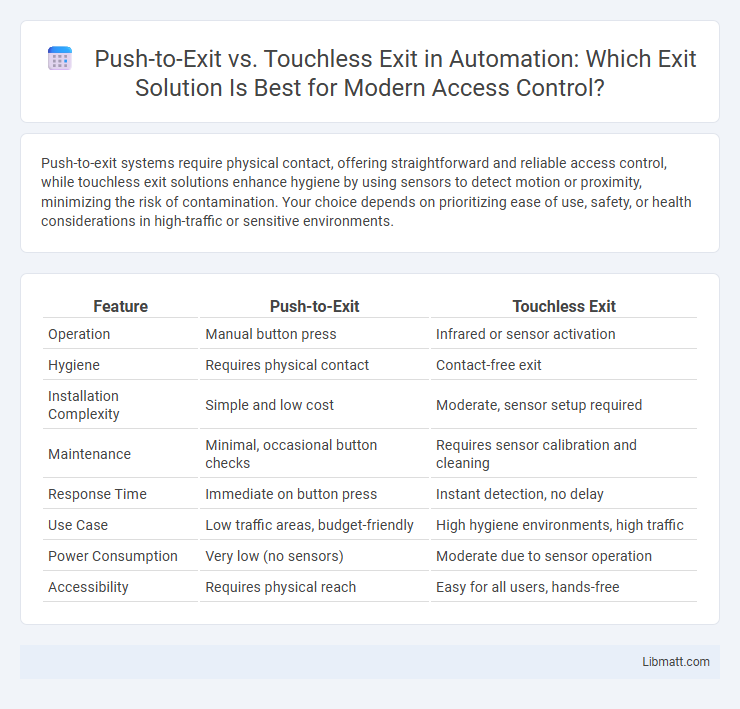Push-to-exit systems require physical contact, offering straightforward and reliable access control, while touchless exit solutions enhance hygiene by using sensors to detect motion or proximity, minimizing the risk of contamination. Your choice depends on prioritizing ease of use, safety, or health considerations in high-traffic or sensitive environments.
Table of Comparison
| Feature | Push-to-Exit | Touchless Exit |
|---|---|---|
| Operation | Manual button press | Infrared or sensor activation |
| Hygiene | Requires physical contact | Contact-free exit |
| Installation Complexity | Simple and low cost | Moderate, sensor setup required |
| Maintenance | Minimal, occasional button checks | Requires sensor calibration and cleaning |
| Response Time | Immediate on button press | Instant detection, no delay |
| Use Case | Low traffic areas, budget-friendly | High hygiene environments, high traffic |
| Power Consumption | Very low (no sensors) | Moderate due to sensor operation |
| Accessibility | Requires physical reach | Easy for all users, hands-free |
Introduction to Door Exit Technologies
Push-to-Exit systems provide a straightforward, tactile method for opening doors by requiring physical pressure on a button or bar, ensuring reliable egress in high-traffic or secure areas. Touchless Exit technologies use motion sensors or infrared detection to allow hands-free door operation, enhancing hygiene and accessibility in environments like hospitals or cleanrooms. Your choice between these technologies depends on factors such as security needs, user convenience, and environmental considerations.
What is Push-to-Exit?
Push-to-Exit is a mechanical or electronic device designed to allow easy egress from secured areas by pressing a button or bar. It ensures safe, quick exit in compliance with building codes and enhances security by controlling access points. Your choice between Push-to-Exit and Touchless Exit depends on the desired balance between physical interaction and hygiene considerations.
What is Touchless Exit?
Touchless Exit is a contactless access control solution that allows users to exit secured areas without physical contact, enhancing hygiene and reducing the spread of pathogens. It typically uses sensors such as motion detectors, proximity sensors, or infrared technology to detect a user's presence and trigger door release automatically. Compared to Push-to-Exit buttons, Touchless Exit systems provide a more convenient and sanitary method of egress in environments like hospitals, offices, and public buildings.
Key Differences Between Push-to-Exit and Touchless Exit
Push-to-Exit systems require physical contact with a button to release a door lock, making them straightforward but potentially less hygienic. Touchless Exit technology uses motion sensors or proximity detectors to open doors without any physical contact, enhancing convenience and reducing the spread of germs. Your choice between these options should consider the need for hygiene, user experience, and integration with existing security systems.
Security Implications of Each Exit Method
Push-to-Exit systems provide physical actuation that can deter unauthorized exits through deliberate manual engagement, enhancing controlled egress security. Touchless Exit solutions reduce contamination risks while maintaining access control, but may be more susceptible to accidental or malicious trigger activations if not properly configured. Evaluating security implications involves balancing physical verification with convenience, ensuring integration with alarm and monitoring systems to prevent unauthorized or unintended exits effectively.
Hygiene and Health Considerations
Push-to-Exit systems require physical contact, increasing the risk of transmitting germs and bacteria, which can be a significant concern in medical and high-traffic environments. Touchless Exit solutions use motion sensors or proximity detection, minimizing contact points and reducing the potential spread of viruses and pathogens. These hygienic advantages make Touchless Exit preferable for maintaining health standards in public spaces and reducing infection risks.
Installation and Maintenance Requirements
Push-to-Exit devices require simple wiring and mounting on the inside of doors, making installation straightforward but prone to mechanical wear over time. Touchless Exit systems involve more complex installation with sensors requiring precise alignment and calibration, often leading to higher initial setup costs. Your maintenance efforts will be lower with touchless technology, as it minimizes physical contact and reduces the likelihood of mechanical failures compared to Push-to-Exit buttons.
Cost Analysis: Push-to-Exit vs Touchless Exit
Push-to-Exit systems generally incur lower upfront costs due to simpler mechanical components and installation requirements compared to Touchless Exit systems, which rely on advanced sensor technology. Maintenance expenses for Push-to-Exit units are minimal but can increase over time with wear and tear, whereas Touchless Exit solutions often require periodic sensor calibration and software updates, adding to long-term costs. Evaluating total cost of ownership involves balancing initial investment with potential operational savings in hygiene and user convenience offered by Touchless Exit technology.
Best Use Cases for Each Technology
Push-to-Exit systems are ideal for secure environments such as offices or healthcare facilities where controlled physical access is necessary and users expect tactile feedback to confirm door release. Touchless Exit solutions excel in high-traffic, hygiene-sensitive areas like hospitals, food processing plants, or public restrooms where minimizing surface contact reduces the spread of germs. Your choice depends on balancing security needs with hygiene priorities and user convenience in the specific setting.
Choosing the Right Exit Solution for Your Facility
Push-to-exit systems require physical contact, making them suitable for environments where security is a priority and controlled egress is necessary. Touchless exit solutions utilize motion sensors or infrared technology to enable hands-free operation, enhancing hygiene and accessibility in high-traffic or healthcare facilities. Selecting the right exit solution depends on balancing security needs, user convenience, and compliance with building codes and accessibility standards.
Push-to-Exit vs Touchless Exit Infographic

 libmatt.com
libmatt.com